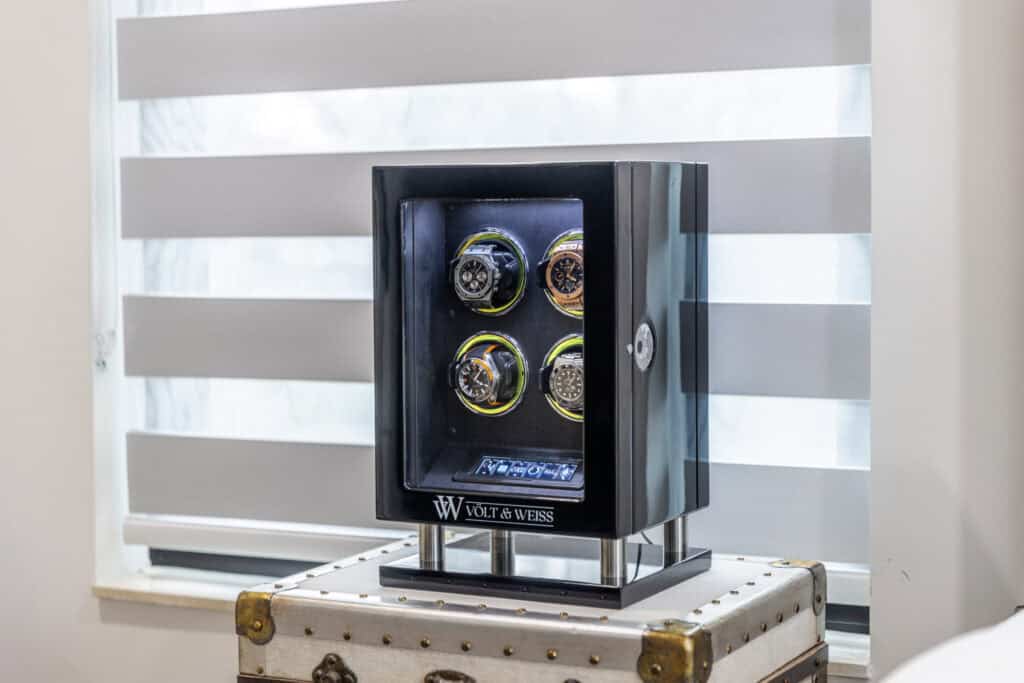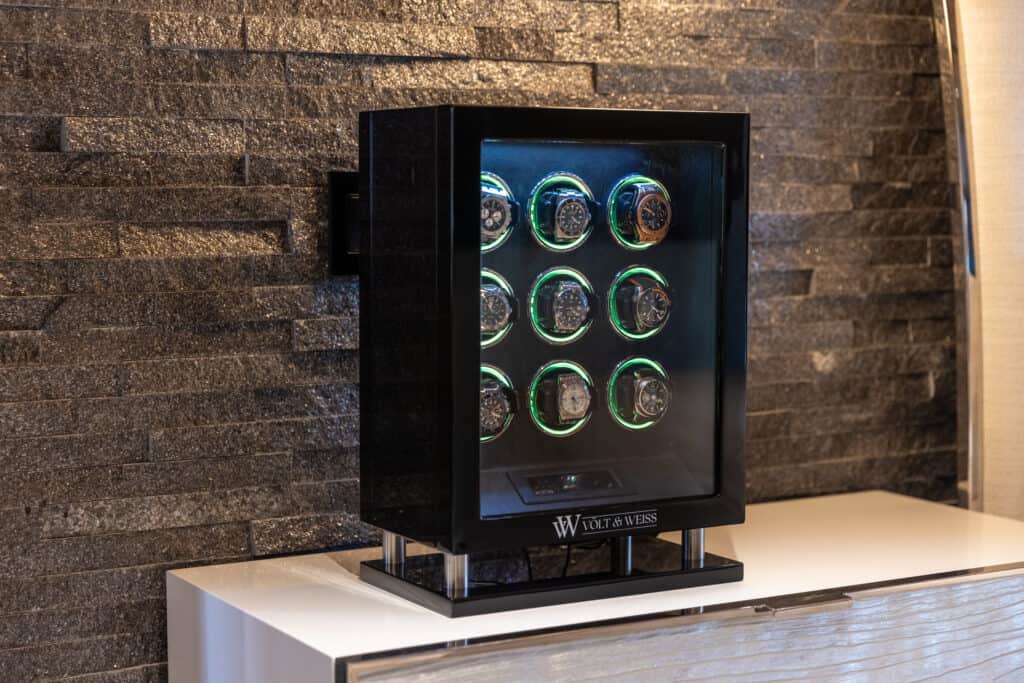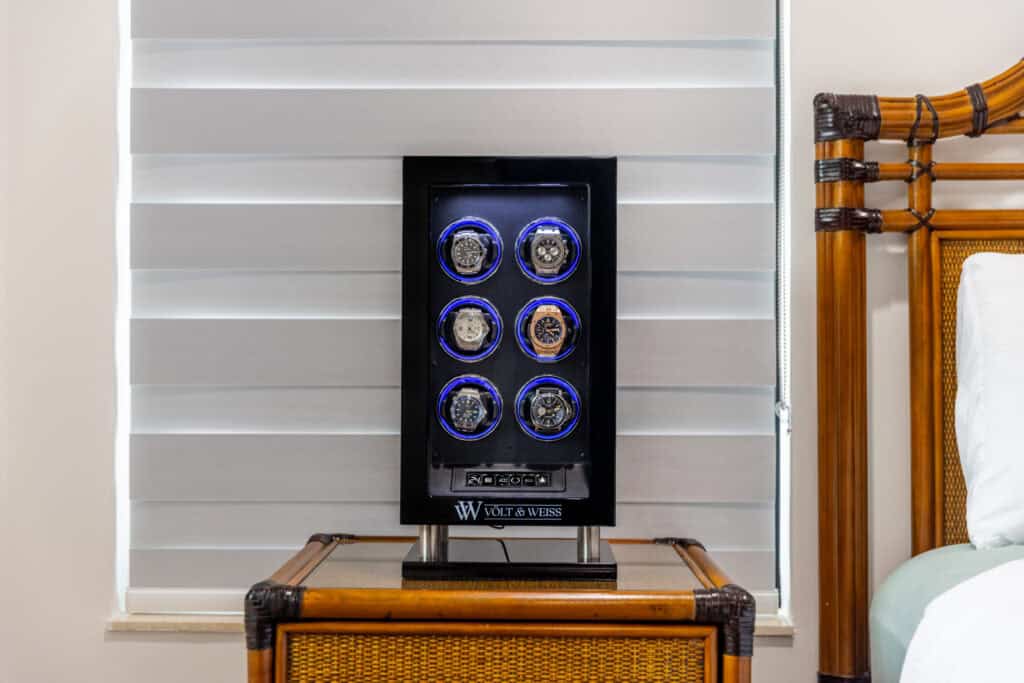Watch enthusiasts often debate the merits of automatic vs mechanical timepieces, each showcasing the pinnacle of horological craftsmanship and offering distinct advantages.
Most people might miss the subtle distinctions between mechanical and automatic watches at first glance. However, these small differences play a major role in daily wear experience and investment potential.
Let’s dive into the unique characteristics of each type – from their intricate movements to their appeal in the market. Understanding the differences between mechanical and automatic watches is vital for collectors. This knowledge becomes especially important when expanding your collection or making your first serious watch investment and when looking for the best mens watch case. Our detailed comparison will help you make an informed decision that matches your collecting priorities.
Understanding Watch Movements
The sort of thing I love about watch movements starts with their role as the heart of timepieces. A watch movement, also known as a “caliber,” powers the watch and drives all its functions.
Simple Mechanics of Watch Movements
A mechanical watch uses a mainspring to store energy that flows through gears and springs to power the balance wheel. This intricate system creates the distinctive ticking sound that watch enthusiasts love. The mainspring releases its stored energy through the escapement in precise increments.
Components of Mechanical Watches
A mechanical watch consists of these vital parts:
- Mainspring: The power source that stores mechanical energy
- Gear Train: Transmits force and adds up balance wheel swings
- Balance Wheel: The timekeeping element oscillating back and forth
- Escapement: Controls power release and creates the ticking sound
- Jewels: Synthetic rubies that reduce friction at points of high wear
Rise of Watch Technology
Watch history traces back to 16th-century Europe, where the first timepieces emerged from portable spring-driven clocks. Early watches were more decorative than practical because they could be off by several hours each day. The most important breakthrough happened in 1657 when watchmakers added the balance spring to the balance wheel. This innovation improved accuracy from several hours to about 10 minutes per day. Progress continued through the centuries until the 1960s brought quartz technology. This electronic revolution delivered unprecedented accuracy, though many collectors still prefer mechanical movements for their craftsmanship and heritage. Modern mechanical watches showcase nearly 600 years of refinement and expertise. Collectors value them highly despite quartz alternatives’ superior accuracy.
Automatic Watch Deep Dive
Let’s take a closer look at the fascinating world of automatic watches, where engineering meets artistry in a self-sustaining timepiece. Automatic watches represent a substantial advancement in watchmaking that builds upon traditional mechanical movements with added convenience and sophistication.
Self-Winding Mechanism Explained
The heart of an automatic watch lies in its self-winding system, powered by a weighted rotor that spins with the natural motion of your wrist. This ingenious mechanism transfers kinetic energy through a series of gears to wind the mainspring automatically. Modern automatic watches can store enough energy to run for 36-48 hours when fully wound. Premium models can maintain power for up to 35 hours even when stationary.
Advantages for Collectors
Automatic watches offer several compelling benefits that make them attractive for collectors:
- Convenience: No daily manual winding needed when worn regularly
- Longevity: With proper care, these timepieces last for generations
- Environmental Impact: No battery changes needed
- Investment Potential: Many models appreciate in value over time
- Craftsmanship: Each piece showcases intricate mechanical artistry

Display cases vs storage boxes
Display cases have caught on with collectors and serve two purposes. The best watch display case comes with:
- LED accent lighting with customizable settings
- High-clarity glass panels
- Touch-screen interfaces
- Remote control capabilities
Storage boxes focus on protection rather than presentation. These best watchbox options include extra compartments for documentation and maintenance tools.
Built-in watch winders
The most sophisticated storage solution combines display features with functional winding mechanisms. Modern watch winders offer amazing versatility and extend the life of automatic timepieces through proper maintenance. Premium winder features now include:
- Japanese Mabuchi motors for silent operation
- Adjustable TPD (300-2300) settings
- Bi-directional rotation options
- Individual slot controls
My extensive testing shows that the best mens watch case with winding capability fits various band sizes (150mm-220mm). These cases let you customize settings for different watch brands and models. Today’s cool watch display options blend sandalwood construction with high-tech features like fingerprint security and digital interfaces. These advanced storage solutions work much better than traditional watch boxes. They protect your collection better and offer improved functionality for serious collectors.
Security Features and Protection
Protection of valuable timepieces has moved beyond simple locks and keys. After investing in premium watches, I found that modern security features make the best mens watch case much safer than traditional options.
Biometric locking systems
Modern watch cases now come with biometric security, which I consider their most impressive feature. Premium cases use fingerprint recognition systems that can store up to 20 unique fingerprints. This gives you complete control over who can access your collection. The digital interface makes programming quick and offers two unlocking methods for backup access. Key security features include:
- Touch-screen control panel
- Admin key override capability
- Fingerprint data encryption
- Remote access monitoring
Climate control technology
Proper climate control plays a vital role in long-term watch protection, even though it might seem less important than security. The best watch display case includes several environmental control elements:
| Feature | Benefit |
| Sandalwood Construction | Natural humidity regulation |
| Acrylic Panels | UV protection |
| Sealed Design | Dust prevention |
| Ventilation System | Temperature stability |

Display cases vs storage boxes
Display cases have caught on with collectors and serve two purposes. The best watch display case comes with:
- LED accent lighting with customizable settings
- High-clarity glass panels
- Touch-screen interfaces
- Remote control capabilities
Storage boxes focus on protection rather than presentation. These best watchbox options include extra compartments for documentation and maintenance tools.
Built-in watch winders
The most sophisticated storage solution combines display features with functional winding mechanisms. Modern watch winders offer amazing versatility and extend the life of automatic timepieces through proper maintenance. Premium winder features now include:
- Japanese Mabuchi motors for silent operation
- Adjustable TPD (300-2300) settings
- Bi-directional rotation options
- Individual slot controls
My extensive testing shows that the best mens watch case with winding capability fits various band sizes (150mm-220mm). These cases let you customize settings for different watch brands and models. Today’s cool watch display options blend sandalwood construction with high-tech features like fingerprint security and digital interfaces. These advanced storage solutions work much better than traditional watch boxes. They protect your collection better and offer improved functionality for serious collectors.
Security Features and Protection
Protection of valuable timepieces has moved beyond simple locks and keys. After investing in premium watches, I found that modern security features make the best mens watch case much safer than traditional options.
Biometric locking systems
Modern watch cases now come with biometric security, which I consider their most impressive feature. Premium cases use fingerprint recognition systems that can store up to 20 unique fingerprints. This gives you complete control over who can access your collection. The digital interface makes programming quick and offers two unlocking methods for backup access. Key security features include:
- Touch-screen control panel
- Admin key override capability
- Fingerprint data encryption
- Remote access monitoring
Climate control technology
Proper climate control plays a vital role in long-term watch protection, even though it might seem less important than security. The best watch display case includes several environmental control elements:
| Feature | Benefit |
| Sandalwood Construction | Natural humidity regulation |
| Acrylic Panels | UV protection |
| Sealed Design | Dust prevention |
| Ventilation System | Temperature stability |
FAQs
Q1. What materials are best for a luxury watch case?
Premium watch cases often combine sandalwood with high-grade PU leather for durability and elegance. They may also feature tempered glass, acrylic panels, and metal reinforcements for added protection and visibility.
Q2. How do multi-watch cases compare to single watch cases?
Multi-watch cases offer better organization for growing collections, with options for 4-9 slots, while single cases excel in portability and focused protection for one valuable timepiece. Multi-watch cases typically have more extensive display options and advanced security features.
Q3. What security features should I look for in a high-end watch case?
Look for biometric locking systems with fingerprint recognition, climate control technology to regulate humidity and temperature, and anti-theft mechanisms like remote monitoring capabilities and LED lighting systems that serve as visual deterrents.
Q4. How can I properly organize my watch collection in a case?
Choose a case with flexible compartment configurations, high-quality watch cushions that support various band sizes, and accessibility features like touch-screen interfaces and remote control capabilities. Ensure the case allows for individual slot control and customizable settings for each watch.
Q5. What should I consider for long-term protection of my watch investment?
Consider dedicated watch insurance for comprehensive coverage, maintain proper documentation including purchase records and service history, and keep detailed maintenance records. Choose a watch case that facilitates easy record-keeping and offers features like built-in digital storage and maintenance reminders.














